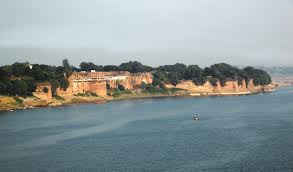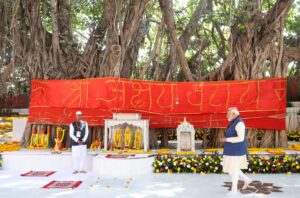Introduction
It was the time back in December when the news was flashing – ‘Prime Minister Narendra Modi is going to inaugurate a project worth Rs. 7000 crore in Prayag amid Kumbh’. As soon as I read the texts displayed on the television, the screen flashed the visuals of the Prime Minister offering worship to a big banyan tree. I whispered to my friend ‘Do you have any idea what this tree is?’. I read through his face, and I found his forehead shrinking while answering my question, but to my amazingness, he somehow managed to utter the word something like – wat……………, vat……….., no!….yes!……Akshay… Akshayavat Tree.
Yureka!….I exclaimed in joy….you are right my friend! I have been confirmed through the News airing the live address of the prime minister. I became attentive and curious to hear him because I was intuited to learn more about this amazing tree ‘Akshayavat’ in his address to which I have zero knowledge.
The Prime Minister read a shloka –
त्रिवेणीं माधवं सोमं, भरद्वाजं च वासुकिम्। वन्दे अक्षय-वटं शेषं, प्रयागं तीर्थनायकम्॥
triveneen maadhavan soman, bhaaradvaajan ch vaasukim. vande akshay-vatan sheshan, prayaagan teerthanaayakam.
While I was trying to figure out the exact meaning of the verse, he started to explain the shloka for my convenience. He explained as –
“The triple effect of the Triveni Sangam, the glory of Veni Madhav, the blessings of Someshwar, the sanctity of Rishi Bharadwaj’s ashram, the special significance of Nagraj Vasuki, the immortality of the Akshaya Vat, and the eternal grace of Shesha—this is our Teerthraj Prayag, the king of pilgrimages”
However, I had written a few articles around the ‘Kumbh’, but I was unaware of the significance of the ‘Akshayavat Tree’. I jumped off to my work chair as soon as the idea of writing a comprehensive article on ‘Akshayavat’ hit my mind. The lines down result from extensive research, many readings, awakened eyes throughout the nights, and restless efforts that I did to make this article insightful for you.
What It Means To ‘Akshayavat’?
As a Hindu and Hindi-speaking guy, I can tell you well that “Akshaya” is a Sanskrit origin word referring to ‘eternal’, ‘indestructible’, or ‘that can’t be harmed ever’ while the word ‘Vat’ refers to ‘Banyan Tree’. Hence, the ‘Akshayavat’ derives the meaning ‘Tha Banayan tree which is indestructible, can’t be harmed and is eternal’.
In India, we Hindus worship the Banyan trees as ‘Deity’ and the many festivals like ‘Vat Savitri Vrat’, ‘Vat Purnima’, etc. revolve around this significant tree. The ‘Vat Vriksh (Banyan tree)’ is at the center of all these Hindu festivals and therefore the tree is sacred to us.
Where Is Akshayavat Tree?
Now, as you learned the meaning of ‘Akshayavat’, you must have been thinking about where the ‘Akshayvat’ tree is located. Okay, hold your breath! I am telling you all about this.
The Akshayvat Tree is located in Praygaraj at Triveni Sangam inside the Patalpuri Temple. The Patalpuri Temple is situated within the campus of Prayagraj Fort.
The Prayagraj Fort was built by Emperor Akbar in 1583 on the bank of the Yamuna River. Therefore this fort is also revered as ‘Akbar Fort’ or ‘Allahabad Fort (Allahabad was the earlier name of Prayagraj)’. However, before the fort was built, there were many temples which were spread in the area around Akshayvat. But, Akbar demolished all the temples and built the fort.
While he made many attempts to harm or root out the tree, he failed in doing so. Therefore, he prohibited the access for Hindus to the tree and shifted the stem of ‘Akshayavat’ to Patalpuri, which we worship now. The locals believe that the ‘Akshayavat Tree’ in Patalpuri temple is a branch. At the same time, the original ‘Akshayavat Tree’ is still inside the fort, where entry is restricted for the people.
Akshayavat Tree In History
Akshayavat Tree Prayagraj lived a long life to tell the history of Prayag, Allahabad, and India. The tree stood firmly in all the times and eras as a main cultural pillar and witnessed many past events revolving around it. It plays the role of a key figure in the canvas of Indian History. I am dividing its journey in Indian history into two parts for easy understanding:
The Golden Era
It is believed that the tree witnessed all the eras in Satyug, Tretayug, Dwaparyug, and Kalyug (The four-time cycles according to Hindu Philosophy). The Hindu Tales says that Lord Krishna rested in the tree leaves in the form of ‘Bal Mukunda’ when the earth was filled with waters and the land was nonexistent.
Later in ‘Tretayug’ Lord Rama and Goddess Sita, rested here for about 3 nights during their 14 years of exile from Ayodhya. It is believed that goddess Sita blessed the tree to be ‘Immortal’. In ‘Dwapar Yug’, when Pandavas were given an exile of 13 years they also came under the ‘Akshayavat Tree’ in Prayag and rested for some while. In ‘Kalyuga’, many great personalities like ‘Lord Buddha’, and ‘Rishabhdev’ came to Prayag to mediate beneath the Akshayavat tree.
Bloodshed Era
The tree has a bloodied history during the reign of the Mughal Emperor. Akbar was the first Mughal emperor who noticed the ‘Akshayavat Tree’. At that time there were many small and large Hindu temples surrounding the tree. As the tree was situated on the bank of ‘Triveni Sangam Prayagraj’, people in large numbers gathered around ‘Kumbh Mela for worship and to participate in holy practices and rituals.
Akbar thought to build a Fort here with the intention of collecting huge taxes from the pilgrimages. Therefore, he demolished all the temples and built the ‘Akbar Fort’, which today we know as the ‘Prayagraj Fort’. He tried to demolish ‘Akshayavat Tree’ as well but didn’t succeed. So, he constructed the fort in such a way that it enclosed this sacred tree and denied the entry and worship of ‘Akshayavat’ by Hindus. Later many other successors of the Mughals tried to harm the tree, they even put an iron rod in its roots to destroy it but failed.

What Is The Age Of Akshayavat Tree?
In the above lines, as you read that the tree has traveled through times and contributed its role in all Yugas, the Hindu believers consider it eternal. It means that the tree has been living for a thousand years. But, according to different sources and as has also been mentioned in many other Hindu sacred texts, the Akshayavat Tree age is estimated around 5000 years. Meanwhile, many other sources suggest it to be older and is believed to be the oldest standing tree on Earth.
Why Does the Akshayavat Tree Matter So Much For Hindus?
The Akshayavat Tree Prayagraj is not just a matter of faith and belief but more than that, it’s the symbol of Indian cultural Heritage, a witness of past events, and a great storyteller of times.
The tree matters not only for Hindus but for everyone whose identity is rooted within the Indian continent – its geography and history.
Religious Significance of Akshayavat Tree
It is believed that whoever comes to Prayag for a holy bath should reach the Patalpuri temple and worship the Akshayavat tree in the Akshavat temple. If they do not do so then their sadhana remains incomplete and they do not get any fruitful results in return.
In another scenario, when Kumbh Mela is held at ‘Triveni Sangam Prayagraj – The confluence of Three Rivers’, a large number of people take bathe in ‘Prayag’ and offer worship to ‘Akshayavat Tree’.
Also, the tree is believed to be the abode of Lord Krishna in the form of ‘Bal Mukunda’. Therefore, the tree is a subject of pure faith, devotion, and reverence for Hindus.
Cultural Significance of Akshayavat Tree
Description about Akshayavat is not only found in Hindu religious texts and Puranas (Padma Puran), but this tree also has a deep connection with Jainism and Buddhism. It is a symbol of Eternity, Regeneration, and Moksha in all (Hinduism, Buddhism, and Jainism).
It is said that Lord Rishabhanah (the first Tirthankar) mediated beneath this tree and got enlightenment. Apart from this, the Bodhi tree under which Lord Buddha attained enlightenment in Bodh Gaya is also considered a manifestation of Akshayavat.
Akshayavat Temple In Present Scenario
In the present scenario, the Akshayavat Temple is under the protection of the Indian Army. Along with taking care of the temple, the army has been given control of the fort and the authority to use it for their various activity. The Indian army sets up their control room at the Fort during Kumbh for security purposes.
Prime Minister Narendra Modi recently allocated a budget of 18 crores for the construction of the ‘Akshayavat corridor’ amid ‘Prayagraj Kumbh Mela 2025’. The corridor will provide easy access to visitors to ‘Akshayavat Temple’ and will guide visitors on the way to ‘Akshayavat Site’. Meanwhile, the facilities for shelters, restrooms, and benches will also be built up to enhance visitors’ experience during Kumbh 2025.

Conclusion
The Akshayavat Tree has traveled a timeless journey of years (something about 5000 years) and stands amidst us as a living symbol of faith, culture, history, heritage, and eternity. With many attempts to cut its root, destroy its identity, and to wash out its existence, the tree regenerated itself again and again and grew profusely. This way, the tree tells us that Its roots are spread not just under the ground of the past but reach the height of a limitless sky of hope for the future. As we are moving forward to a developed nation, it is our duty to restore our cultural heritage, otherwise, the history will be penned off differently from what the reality is.


